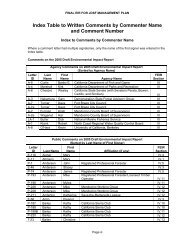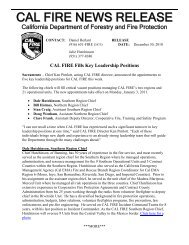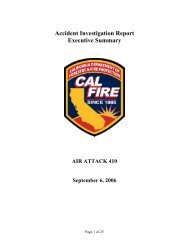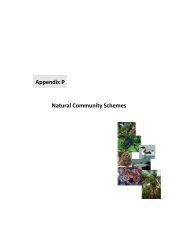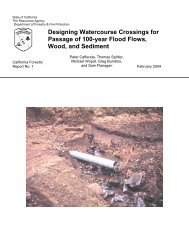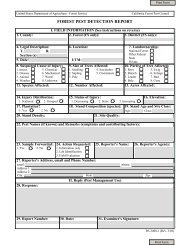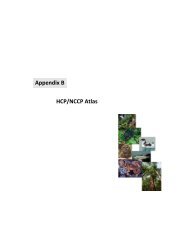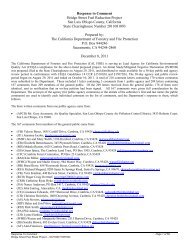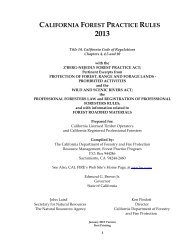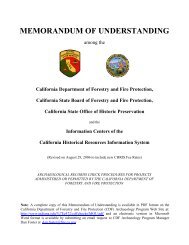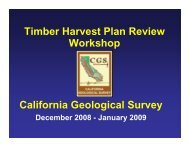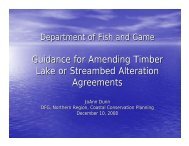nonindustrial timber management plan - Cal Fire - State of California
nonindustrial timber management plan - Cal Fire - State of California
nonindustrial timber management plan - Cal Fire - State of California
You also want an ePaper? Increase the reach of your titles
YUMPU automatically turns print PDFs into web optimized ePapers that Google loves.
FOR ADMIN. USE ONLY<br />
Amendments-date & S or M<br />
1. 7.<br />
2. 8.<br />
3. 9.<br />
4. 10.<br />
5. 11.<br />
6. 12.<br />
NONINDUSTRIAL TIMBER<br />
MANAGEMENT PLAN<br />
STATE OF CALIFORNIA<br />
DEPARTMENT OF FORESTRY<br />
AND FIRE PROTECTION<br />
RM - 68 (Rev. 08-05)<br />
NTMP Name:<br />
(In the CDF FPS, this is “THP Description”)<br />
FOR ADMIN. USE ONLY<br />
NTMP #<br />
Dates Rec'd<br />
Date Filed<br />
Date Approved<br />
This Nonindustrial Timber Management Plan (NTMP) form, when properly completed, is designed to comply with the Forest Practice Act (FPA) and<br />
Board <strong>of</strong> Forestry and <strong>Fire</strong> Protection rules. If financial assistance is requested to cover some <strong>of</strong> the expenses <strong>of</strong> the NTMP, contact the local<br />
CDF Forestry Assistance Specialist prior to preparation <strong>of</strong> the NTMP. See separate instructions for information on completing this form. NOTE:<br />
The form must be printed legibly in ink, typewritten, or electronically printed. The NTMP is divided into six sections. If more space is necessary to<br />
answer a question, continue the answer at the end <strong>of</strong> the appropriate section <strong>of</strong> your NTMP. However, if writing an electronic version, insert additional<br />
space for your answer. Distinguish answers from questions by font change, bold or underline.<br />
SECTION I - GENERAL INFORMATION<br />
This NTMP conforms to my/our <strong>plan</strong> and upon approval, I/we agree to conduct harvesting in accordance therewith. Consent is hereby given to<br />
the Director <strong>of</strong> Forestry and <strong>Fire</strong> Protection, and his or her agents and employees, to enter the premises to inspect <strong>timber</strong> operations for<br />
compliance with the Forest Practice Act and Forest Practice Rules.<br />
1. TIMBER OWNER(S) OF RECORD: Name<br />
Address<br />
City <strong>State</strong> Zip Phone<br />
Signature<br />
Date<br />
NOTE: The <strong>timber</strong> owner is responsible for payment <strong>of</strong> a yield tax. Timber Yield Tax information may be obtained at the Timber<br />
Tax Division, <strong>State</strong> Board <strong>of</strong> Equalization, P.O. Box 942879, Sacramento, <strong>Cal</strong>ifornia 94279-0060; phone 1-800-400-7115;<br />
BOE Web Page at http:// www.boe.ca.gov.<br />
2. TIMBERLAND OWNER(S) OF RECORD: Name<br />
Address<br />
City <strong>State</strong> Zip Phone<br />
Signature<br />
Date<br />
3. LICENSED TIMBER OPERATOR(S): Name Lic. No.<br />
Address<br />
City <strong>State</strong> Zip Phone<br />
NOTE: If LTO is not known upon <strong>plan</strong> submission, submit information in a Notice <strong>of</strong> Timber Operations as per 14 CCR 1090.7.<br />
Signature<br />
Date<br />
4. PLAN SUBMITTER(S): See Timberland Owner above, Item 2<br />
5. a. If LTO is not present on-site, list person to contact on-site who is responsible for the conduct <strong>of</strong> the operation . If unknown,<br />
so state, but name must be included on each Notice <strong>of</strong> Timber Operations or amended into NTMP.<br />
Name<br />
Address<br />
1
City <strong>State</strong> Zip Phone<br />
b. [ ] Yes [ ] No Will the <strong>timber</strong> operator be employed for the construction and maintenance <strong>of</strong> roads and landings<br />
during conduct <strong>of</strong> <strong>timber</strong> operations? If no, who is responsible?<br />
c. Who is responsible for erosion control maintenance after <strong>timber</strong> operations have ceased and until certification <strong>of</strong> the<br />
Work Completion Report? If not the LTO, then a written agreement must be provided per 14 CCR 1050(c).<br />
6. Expected date <strong>of</strong> commencement <strong>of</strong> <strong>timber</strong> operations, which in addition will require filing a Notice <strong>of</strong> Timber Operations:<br />
[ ] date <strong>of</strong> NTMP conformance, or [ ] (date)<br />
7. The <strong>timber</strong> operation will occur within the:<br />
[ ] COAST FOREST DISTRICT [ ] The Tahoe Regional Planning Authority Jurisdiction<br />
[ ] Southern Subdistrict <strong>of</strong> the Coast F.D. [ ] A County with Special Regulations, identify:<br />
[ ] SOUTHERN FOREST DISTRICT [ ] Coastal Zone, no Special Treatment Area.<br />
[ ] High use subdistrict <strong>of</strong> the Southern F.D. [ ] Special Treatment Area(s), type and identify:<br />
[ ] NORTHERN FOREST DISTRICT [ ] Other<br />
8. Location <strong>of</strong> the <strong>timber</strong> operation by legal description:<br />
Base and Meridian: [ ] Mount Diablo; [ ] Humboldt; [ ] San Bernardino.<br />
Section Township Range Acreage County Assessor's Parcel Number (Optional)<br />
TOTAL ACREAGE<br />
(Logging Area Only)<br />
U.S. Geological Survey (USGS) Quadrangle name(s) and date(s):<br />
9. Planning Watershed: CALWATER 2.2, Identification Number, and Name:<br />
10. [ ] Yes [ ] No Has a Timberland Conversion been submitted and approved? If yes, list approval date, permit<br />
number, and expiration date.<br />
11. [ ] Yes [ ] No Is there a THP or NTMP on file with CDF for any portion <strong>of</strong> the <strong>plan</strong> area for which a report <strong>of</strong><br />
satisfactory stocking has not been issued by CDF? If yes, identify the THP or NTMP number(s):<br />
12. [ ] Yes [ ] No Is a Notice <strong>of</strong> Preparation necessary for this NTMP?<br />
[ ] Yes [ ] No If yes, was a Notice <strong>of</strong> Preparation (NOP) posted as required by 14 CCR 1090.2(g)?<br />
2
13. RPF preparing the NTMP: Name RPF Number<br />
Address<br />
City <strong>State</strong> Zip Phone<br />
a. [ ] Yes [ ] No I have notified the <strong>plan</strong> submitter(s), in writing, <strong>of</strong> their responsibilities pursuant to Title 14 CCR<br />
1090.9 -10 <strong>of</strong> the Forest Practice Rules, <strong>of</strong> their responsibilities for compliance with the Forest<br />
Practice Act and Board rules, and where applicable, Board rules regarding site preparation,<br />
stocking, and maintenance <strong>of</strong> roads, landings, and erosion control facilities.<br />
b. [ ] Yes [ ] No I or my supervised designee will meet with the LTO prior to commencement <strong>of</strong> operations to<br />
advise <strong>of</strong> sensitive conditions and provisions <strong>of</strong> the <strong>plan</strong> pursuant to 14 CCR 1090.11.<br />
c. [ ] Yes [ ] No I will provide the LTO with a copy <strong>of</strong> the approved NTMP and Notice <strong>of</strong> Timber Operations (NTO)<br />
as per 14 CCR 1090.9(e) and (g). If no, who will provide the LTO a copy <strong>of</strong> the approved<br />
NTMP, subsequent amendments, and NTO?<br />
d. I have the following authority and responsibilities for preparation and administration <strong>of</strong> the NTMP and <strong>timber</strong> operation.<br />
(Include both work completed and work remaining to be done):<br />
e. Additional required work requiring an RPF, which I do not have the authority or responsibility to perform:<br />
f. After considering the rules <strong>of</strong> the Board <strong>of</strong> Forestry and <strong>Fire</strong> Protection and the mitigation measures incorporated in this<br />
NTMP, I have determined that the <strong>timber</strong> operation:<br />
[ ] will have a significant adverse impact on the environment. (<strong>State</strong>ment <strong>of</strong> reasons for overriding considerations<br />
contained in Section III)<br />
[ ] will not have a significant adverse impact on the environment.<br />
Registered Pr<strong>of</strong>essional Forester: I certify that I, or my supervised designee, personally inspected the NTMP area, and this<br />
<strong>plan</strong> complies with the Forest Practice Act, the Forest Practice Rules and the Pr<strong>of</strong>essional Foresters Law.<br />
Signature<br />
Date<br />
3
SECTION II - PLAN OF TIMBER OPERATIONS<br />
NOTE: If a provision <strong>of</strong> this NTMP is proposed that is different than the standard rule, the ex<strong>plan</strong>ation and<br />
justification required must be included in Section III <strong>of</strong> the NTMP<br />
14. a. Check the Silvicultural methods or treatments allowed by the rules that are to be applied under this NTMP. Specify<br />
the option chosen to demonstrate Maximum Sustained Production (MSP) according to 14 CCR 913[933, 953].11.<br />
If more than one method or treatment will be used show boundaries on map and list approximate acreage for each.<br />
[ ] Selection ac. [ ] Group Selection ac. [ ] Transition ac.<br />
[ ] Commercial Thinning ac. [ ] Road Right <strong>of</strong> Way ac. [ ] Sanitation Salvage ac.<br />
[ ] Special Treatment Area ac. [ ] Rehab <strong>of</strong> Understocked Area ac. [ ] Fuelbreak ac.<br />
[ ] Alternative ac. [ ] Conversion ac. [ ] Non Timberland area ac.<br />
Total acreage ac.: Explain if total is different than in Item 8. MSP option chosen: (b) [ ] (c) [ ]<br />
b. If Selection, Group Selection, Commercial Thinning, Sanitation Salvage or Alternative methods are selected, the post<br />
harvest stand stocking levels (differentiated by site if applicable) must be stated in the NTMP. Note mapping requirements <strong>of</strong><br />
14 CCR 1090.5 (w)(12).<br />
c. Trees to be harvested or retained must be marked by or marked under the supervision <strong>of</strong> the RPF. Specify how the trees<br />
will be marked/designated:<br />
[ ] Yes [ ] No Is a waiver <strong>of</strong> marking by the RPF requirement requested? If yes, how will LTO determine which<br />
trees will be harvested or retained? If more than one silvicultural method or Group Selection is<br />
to be used, how will LTO determine boundaries <strong>of</strong> different methods or groups?<br />
d. Forest Products to be harvested:<br />
e. [ ] Yes [ ] No Are group B species proposed for <strong>management</strong>?<br />
[ ] Yes [ ] No Are group B or non-indigenous A species to be used to meet stocking standards?<br />
[ ] Yes [ ] No Will group B species need to be reduced to maintain relative site occupancy <strong>of</strong> A species?<br />
If any answer is yes, list the species, describe treatment, and provide the LTO with necessary felling and slash<br />
treatment guidance. Explain who is responsible and what additional follow-up measures <strong>of</strong> manual treatment or<br />
herbicide treatment is to be expected to maintain relative site occupancy <strong>of</strong> A species. Explain when a licensed Pest Control<br />
Advisor shall be involved in this process.<br />
4
f. Other instructions to LTO concerning felling operations.<br />
g. [ ] Yes [ ] No Will artificial regeneration be required to meet stocking standards?<br />
h. [ ] Yes [ ] No Will site preparation be used to meet stocking standards? If yes, provide the information required<br />
for a site preparation addendum, as per 14 CCR 915.4 [935.4, 955.4].<br />
i. If the rehabilitation method is chosen, provide a regeneration <strong>plan</strong> as required by 14 CCR 913[933, 953].4(b).<br />
PESTS<br />
15. a. [ ] Yes [ ] No Is this NTMP within an area that the Board <strong>of</strong> Forestry and <strong>Fire</strong> Protection has declared a Zone<br />
<strong>of</strong> Infestation or Infection pursuant to PRC 4716? If yes, identify feasible measures<br />
being taken to mitigate adverse infestation or infection impacts from the <strong>timber</strong> operation.<br />
See 14 CCR 917[937, 957].9(a).<br />
b. [ ] Yes [ ] No If outside a declared zone, are there any insect, disease or pest problems <strong>of</strong> significance in the<br />
NTMP area? If yes, describe the proposed measures to improve the health, vigor and<br />
productivity <strong>of</strong> the stand(s).<br />
HARVESTING PRACTICES<br />
16. Indicate type <strong>of</strong> yarding system and equipment to be used:<br />
GROUND BASED* CABLE SPECIAL<br />
a. [ ] Tractor, including end/long lining d. [ ] Cable, ground lead g. [ ] Animal<br />
b. [ ] Rubber tired skidder, Forwarder e. [ ] Cable, high lead h. [ ] Helicopter<br />
c. [ ] Feller buncher f. [ ] Cable, Skyline i. [ ] Other<br />
* All tractor operations restrictions apply to ground based equipment.<br />
17. Erosion Hazard Rating: Indicate Erosion Hazard Ratings present on NTMP. (Must match EHR worksheets)<br />
Low [ ] Moderate [ ] High [ ] Extreme [ ]<br />
If more than one rating is checked, areas must be delineated on map to 20 acres in size (10 acres for high and extreme<br />
EHRs in the Coast District).<br />
5
18. Soil Stabilization:<br />
In addition to the standard waterbreak requirements describe soil stabilization measures or additional erosion control<br />
measures to be implemented and the location <strong>of</strong> their application, as per requirements <strong>of</strong> 14 CCR 916.7[936.7, 956.7], 923.2<br />
[943.2, 963.2](m), and 923.5[943.5, 963.5](f).<br />
19. [ ] Yes [ ] No Are tractor or skidder constructed layouts to be used? If yes, specify the location and extent <strong>of</strong> use:<br />
20. [ ] Yes [ ] No Will ground based equipment be used within the area(s) designated for cable yarding? If yes,<br />
specify the location and for what purpose the equipment will be used? See 14 CCR 914.3<br />
[934.3, 954.3](e).<br />
21. Within the NTMP area will ground based equipment be used on:<br />
a. [ ] Yes [ ] No Unstable soils or slide areas? Only allowed if unavoidable.<br />
b. [ ] Yes [ ] No Slopes over 65%?<br />
c. [ ] Yes [ ] No Slopes over 50% with high or extreme EHR?<br />
d. [ ] Yes [ ] No Slopes between 50% and 65% with moderate EHR where heavy equipment use will not be<br />
restricted to the limits described in 14 CCR 914[934, 954].2(f)(2)(i) or (ii)?<br />
e. [ ] Yes [ ] No Slopes over 50% which lead without flattening to sufficiently dissipate water flow and trap<br />
sediment before it reaches a watercourse or lake?<br />
If “ a.” is yes, provide site specific measures to minimize effect <strong>of</strong> operations on slope stability and provide ex<strong>plan</strong>ation<br />
and justification in Section III as required per 14 CCR 914[934, 954].2(d). CDF requests the RPF consider flagging<br />
tractor road locations if “ a.” is yes.<br />
If “b., c., d., or e.” is yes:<br />
1) the location <strong>of</strong> tractor roads must be flagged on the ground prior to the PHI or start <strong>of</strong> operations if a PHI is<br />
not required, and<br />
2) you must clearly explain the proposed exception and justify why the standard rule is not feasible or would<br />
not comply with 14 CCR 914[934, 954].<br />
The location <strong>of</strong> heavy equipment operation on unstable areas or any use beyond the limitations <strong>of</strong> the standard rules<br />
must be shown on the map. List specific instructions to the LTO below.<br />
22. [ ] Yes [ ] No Are any alternative practices to the standard harvesting or erosion control rules proposed for this<br />
<strong>plan</strong>? If yes, provide all <strong>of</strong> the information as required in 14 CCR 914.9 (934.9, 954.9) and<br />
1090.5 (dd) in Section III. List specific instructions to the LTO below.<br />
6
WINTER OPERATIONS<br />
23. a. [ ] Yes [ ] No Will <strong>timber</strong> operations occur during the winter period? If yes, complete “b.”, and then “c.” or “d.”<br />
<strong>State</strong> in space provided if exempt because yarding method will be cable, helicopter, or balloon.<br />
b. [ ] Yes [ ] No Will mechanical site preparation be conducted during the winter period? If yes, complete “d.”<br />
c. [ ] I choose the in-lieu option as allowed in 14 CCR 914[934, 954].7(c) and 1090.5(bb). Specify below the<br />
procedures listed in subsections (1) and (2), and list the site specific measures for operations in the WLPZ and<br />
unstable areas as required by subsection (3), if there will be no winter operations in these areas, so state.<br />
d. [ ] I choose to prepare a winter operating <strong>plan</strong> per 14 CCR 914[934, 954].7(b) and 1090.5(bb).<br />
NOTE: “Winter period” means the period between November 15 and April 1, except as noted under special County<br />
Rules at Title 14 CCR 925.1, 926.18, 927.1, and 965.5… (a) except as otherwise provided in the rules: (1) All<br />
waterbreaks shall be installed no later than the beginning <strong>of</strong> the winter period <strong>of</strong> the current year <strong>of</strong> <strong>timber</strong> operation.<br />
(2) Installation <strong>of</strong> drainage facilities and structures is required from October 15 to November 15 and April 1 to May 1<br />
on all constructed skid trails and tractor roads prior to sunset if the National Weather Service forecast is a “chance”<br />
(30% or more) <strong>of</strong> rain within the next 24 hours.<br />
ROADS AND LANDINGS<br />
24. Will any roads be constructed? [ ] Yes [ ] No, or reconstructed? [ ] Yes [ ] No. If yes, check items a through g.<br />
Will any landings be constructed? [ ] Yes [ ] No, or reconstructed? [ ] Yes [ ] No. If yes, check items h through k:<br />
a. [ ] Yes [ ] No Will new or reconstructed roads be wider than single lane with turnouts?<br />
b. [ ] Yes [ ] No Are logging roads proposed in areas <strong>of</strong> unstable soils or known slide-prone areas?<br />
c. [ ] Yes [ ] No Will new roads exceed a grade <strong>of</strong> 15% or have pitches <strong>of</strong> up to 20% for distances greater<br />
than 500 feet? Map must identify any new or reconstructed road segments that exceed an<br />
average 15% grade for over 200 feet.<br />
d. [ ] Yes [ ] No Are roads to be constructed or reconstructed, other than crossings, within the WLPZ <strong>of</strong> a<br />
watercourse? If yes, completion <strong>of</strong> NTMP Item 27 a. will satisfy required documentation.<br />
e. [ ] Yes [ ] No Will roads longer than 100 feet in length be located on slopes over 65%, or on slopes over<br />
50% which are within 100 feet <strong>of</strong> the boundary <strong>of</strong> a WLPZ?<br />
f. [ ] Yes [ ] No Will any roads or watercourse crossings be abandoned?<br />
g. [ ] Yes [ ] No Are exceptions proposed for flagging or otherwise identifying the location or roads to be<br />
constructed?<br />
h. [ ] Yes [ ] No Will any landings exceed one half acre in size? If any landing exceeds one quarter acre in size<br />
or requires substantial excavation the location must be shown on the map.<br />
i. [ ] Yes [ ] No Are any landings proposed in areas <strong>of</strong> unstable soils or known slide prone areas?<br />
j. [ ] Yes [ ] No Will any landings be located on slopes over 65% or on slopes over 50% which are within 100<br />
feet <strong>of</strong> the boundary <strong>of</strong> a WLPZ?<br />
k. [ ] Yes [ ] No Will any landings be abandoned?<br />
25. If any section in item 24 is answered yes, specify site-specific measures to reduce adverse impacts and list any<br />
additional or special information needed by the LTO concerning the construction, maintenance and/or abandonment <strong>of</strong><br />
roads or landings as required by 14 CCR Article 12 [Article 11. Northern] and 1090.5(q, bb, ee, gg, and hh). Include required<br />
ex<strong>plan</strong>ation and justification in NTMP Section III.<br />
7
WATERCOURSE AND LAKE PROTECTION ZONE (WLPZ) AND DOMESTIC WATER SUPPLY PROTECTION MEASURES:<br />
26. a. [ ] Yes [ ] No Are there any watercourse or lakes which contain Class I through IV waters on or adjacent to<br />
the <strong>plan</strong> area? If yes, list the class, WLPZ or ELZ width, and protective measures<br />
determined from Table I and/or 14 CCR 916[936, 956].4(c) <strong>of</strong> the WLPZ rules<br />
for each watercourse. Specify if Class III or IV watercourses have WLPZ , ELZ or both.<br />
b. [ ] Yes [ ] No Are there any watercourse crossings that require mapping per 14 CCR 1090.5(w)(7)?<br />
c. [ ] Yes [ ] No Will tractor road watercourse crossings involve the use <strong>of</strong> a culvert? If yes state minimum<br />
diameter and length for each culvert (may be shown on map).<br />
d. [ ] Yes [ ] No Is this NTMP Review Process to be used to meet Department <strong>of</strong> Fish and Game CEQA review<br />
requirements? If yes, attach the 1611 Addendum below or at the end <strong>of</strong> this Section II;<br />
provide the background information and analysis in Section III; list instructions for LTO<br />
below for the installation, protection measures and mitigation measures; see CDF Mass<br />
Mailing, 07/02/1999, “Fish and Game Code 1603 Agreements and THP Documentation”.<br />
27. Are site specific practices proposed in-lieu <strong>of</strong> the following standard WLPZ practices?<br />
a. [ ] Yes [ ] No Prohibition <strong>of</strong> the construction or reconstruction <strong>of</strong> roads, construction or use <strong>of</strong> tractor roads or<br />
landings in Class I, II, III, or IV watercourses, WLPZs, marshes, wet meadows, and other wet<br />
areas except as follows:<br />
(1) At prepared tractor road crossings.<br />
(2) Crossings <strong>of</strong> Class III watercourses which are dry at time <strong>of</strong> <strong>timber</strong> operations.<br />
(3) At existing road crossings.<br />
`<br />
(4) At new tractor and road crossings approved by Department <strong>of</strong> Fish and Game.<br />
b. [ ] Yes [ ] No Retention <strong>of</strong> non-commercial vegetation bordering and covering meadows and wet areas?<br />
c. [ ] Yes [ ] No Directional felling <strong>of</strong> trees within the WLPZ away from the watercourse or lake?<br />
d. [ ] Yes [ ] No Decrease <strong>of</strong> width(s) <strong>of</strong> the WLPZ(s)?<br />
e. [ ] Yes [ ] No Protection <strong>of</strong> watercourses which conduct class IV waters?<br />
f. [ ] Yes [ ] No Exclusion <strong>of</strong> heavy equipment from the WLPZ except as follows:<br />
(1) At prepared tractor road crossings.<br />
(2) Crossings <strong>of</strong> Class III watercourses which are dry at time <strong>of</strong> <strong>timber</strong> operations.<br />
(3) At existing road crossings.<br />
`<br />
(4) At new tractor and road crossings approved by Department <strong>of</strong> Fish and Game.<br />
g. [ ] Yes [ ] No Establishment <strong>of</strong> ELZ for Class III watercourses unless sideslopes are
28. a. [ ] Yes [ ] No Are there any landowners within 1000 feet downstream <strong>of</strong> the NTMP boundary whose ownership<br />
adjoins or includes a class I, II, or IV watercourse(s) which receives surface drainage from the<br />
proposed <strong>timber</strong> operations? If yes, the requirements <strong>of</strong> 14 CCR 1032.10 apply. Pro<strong>of</strong> <strong>of</strong> notice<br />
by letter and newspaper must be enclosed in NTMP Section V. If No, Item 28 b. need not be<br />
answered.<br />
b. [ ] Yes [ ] No Is an exemption requested <strong>of</strong> the notification requirements <strong>of</strong> 14 CCR 1032.10? If yes,<br />
ex<strong>plan</strong>ation and justification for the exemption must be included. Specify if requesting an<br />
exemption from the letter, the newspaper notice, or both.<br />
c. [ ] Yes [ ] No Was any information received on domestic water supplies that required additional mitigation<br />
beyond that required by standard Watercourse and Lake Protection rules? If Yes, list site<br />
specific measures to be implemented by the LTO.<br />
29. [ ] Yes [ ] No Is any part <strong>of</strong> the NTMP area within a Sensitive Watershed as designated by the Board <strong>of</strong> Forestry<br />
and <strong>Fire</strong> Protection? If yes, identify the watershed and list any special rules, operating<br />
procedures or mitigation that will be used to protect the resources identified at risk?<br />
HAZARD REDUCTION:<br />
30. a. [ ] Yes [ ] No Are there roads or improvements which require slash treatment adjacent to them? If yes, specify<br />
the type <strong>of</strong> improvement, treatment distance, and treatment method.<br />
b. [ ] Yes [ ] No Are any alternatives to the rules for slash treatment along roads and within 200 feet <strong>of</strong><br />
structures requested? If yes, RPF must explain and justify how alternative provides equal<br />
fire protection. Include a description <strong>of</strong> the alternative and where it will be utilized below.<br />
31. [ ] Yes [ ] No Will piling and burning be used for hazard reduction? See 14 CCR 917.2-7 and 9, 937.2-3, 5-7 and<br />
9 or 957.2-7 and 9 for specific requirements. Note: LTO is responsible for slash disposal. This<br />
responsibility cannot be transferred.<br />
BIOLOGICAL AND CULTURAL RESOURCES<br />
32. a. [ ] Yes [ ] No Are any <strong>plan</strong>t or animal species, including their habitat, which are listed as rare, threatened or<br />
endangered under federal or state law, or a sensitive species by the Board, associated with<br />
the NTMP area? If yes, identify the species and the provisions to be taken for the protection <strong>of</strong><br />
the species.<br />
b. [ ] Yes [ ] No Are there any non-listed species which will be significantly impacted by the operation? If yes,<br />
identify the species and the provisions to be taken for the protection <strong>of</strong> the species.<br />
NOTE: See instructions or the CDF Mass Mailing, 07/02/1999, section on “CDF Guidelines for Species Surveys and<br />
Mitigations” to complete these questions.<br />
9
33. [ ] Yes [ ] No Are there any snags which must be felled for fire protection or safety reasons? If yes, describe<br />
which snags are going to be felled and why.<br />
34. [ ] Yes [ ] No Are any Late Succession Forest Stands proposed for harvest? If yes, describe the measures to<br />
be implemented by the LTO that avoid long-term significant adverse effects on fish, wildlife and<br />
listed species known to be primarily associated with late succession forests.<br />
35. [ ] Yes [ ] No Are any other provisions for wildlife protection required by the rules? If yes, describe.<br />
36. a. [ ] Yes [ ] No Has an archaeological survey been made <strong>of</strong> the NTMP area?<br />
b. [ ] Yes [ ] No Has an archaeological records check been conducted for the NTMP area?<br />
c. [ ] Yes [ ] No Are there any archaeological or historical sites located in the NTMP area? Specific site locations<br />
and protection measures are contained in the Confidential Archaeological Addendum in<br />
Section VI <strong>of</strong> the NTMP, which is not available for general public review.<br />
37. [ ] Yes [ ] No Has any inventory or growth and yield information designated "trade secret" been submitted in a<br />
separate confidential envelope in Section VI <strong>of</strong> this NTMP?<br />
38. Describe any special instructions or constraints that are not listed elsewhere in Section II, and specify their location in the<br />
NTMP if not listed immediately below:<br />
39. Describe present and proposed <strong>plan</strong> area uses other than <strong>timber</strong> production, include in Section III, as per 14 CCR 1090.5(f).<br />
40. Provide a description by <strong>management</strong> unit(s) <strong>of</strong> the <strong>timber</strong> stand characteristics including the items listed below, in Section III.<br />
Such description shall provide the basis for the information provided in the NTMP, as per 14 CCR 1090.5(g):<br />
a. Species composition;<br />
b. age classes;<br />
c. projected growth;<br />
d. present stocking level;<br />
e. present volume per acre;<br />
f. size class distribution;<br />
g. stand <strong>management</strong> history;<br />
h. potential pest or protection problems.<br />
10
41. Provide a description by <strong>management</strong> unit(s) <strong>of</strong> the proposed <strong>management</strong> objectives, including a discussion <strong>of</strong> projected<br />
<strong>timber</strong> volumes and sizes available for <strong>timber</strong> harvesting in Section III, as per 14 CCR 1090.5(h).<br />
42. Provide a description by <strong>management</strong> unit(s) <strong>of</strong> proposed activities to achieve the <strong>management</strong> objectives, include in<br />
Section III, as per 14 CCR 1090.5(i):<br />
a. projected frequencies <strong>of</strong> harvest;<br />
b. silvicultural prescriptions for harvesting;<br />
c. type <strong>of</strong> yarding systems to be used for each area/unit;<br />
d. anticipated interim <strong>management</strong> activities which may result in rule compliance questions (i.e., erosion control<br />
maintenance).<br />
43. Provide the period <strong>of</strong> time over which growth will be balanced with harvest in Section III, as per 14 CCR 1090.5(j).<br />
44. Provide a description <strong>of</strong> the cumulative effects analysis with supporting information, including impact <strong>of</strong> projected harvesting<br />
over the life <strong>of</strong> the NTMP, per 14 CCR 1090.5(u).<br />
45. Maps and drawings. Include as per 14 CCR 1090.5(w) and as needed; insert in Sections II and/or III, as appropriate.<br />
46. [ ] Yes [ ] No A copy <strong>of</strong> the forest practice regulations in effect at the time <strong>of</strong> submission is enclosed, as per 14<br />
CCR 1090.5(v). If no, the <strong>plan</strong> is incomplete: an ex<strong>plan</strong>ation <strong>of</strong> how a copy <strong>of</strong> the regulations<br />
will be maintained by the <strong>timber</strong>land owner must be included.<br />
47. a. [ ] Yes [ ] No This NTMP will be used for one or more <strong>of</strong> the forestry assistance programs for non-industrial<br />
forest landowners. If yes, answer b., below.<br />
b. [ ] Yes [ ] No If yes, this NTMP has the additional information as an Addendum in Section III. If no, the<br />
information will be amended into the <strong>plan</strong> at a later time.<br />
Note: The NTMP when expanded with additional information can meet the requirements to participate in state and<br />
federal cost-share programs. It is even possible for these programs to help <strong>of</strong>fset the cost <strong>of</strong> preparing the NTMP.<br />
Contact your local Forestry Assistance Specialist (FAS) for further information concerning these programs; call toll<br />
free 1-800-783-TREE.<br />
DIRECTOR OF FORESTRY AND FIRE PROTECTION<br />
This Nonindustrial Timber Management Plan conforms to the rules and regulations <strong>of</strong> the Board <strong>of</strong> Forestry and <strong>Fire</strong> Protection and the<br />
Forest Practice Act:<br />
By:<br />
(Signature)<br />
(Date)<br />
(Printed Name)<br />
(Title)<br />
11



